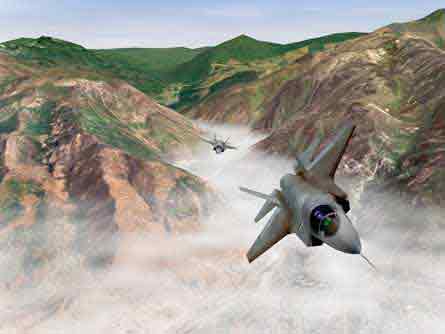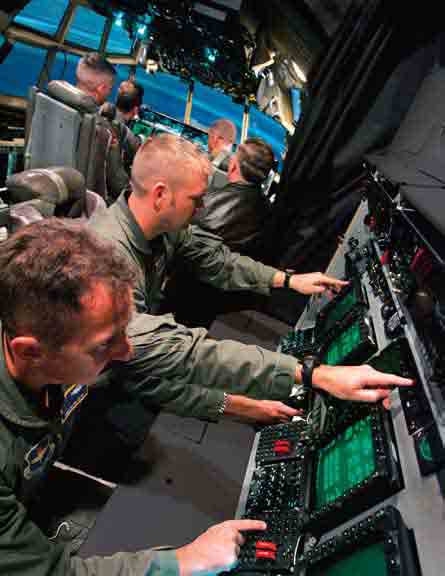The past year has seen non-incumbents snatch key contracts in the military simulator market, as the pace of competition remains intense
Being the incumbent supplier is a good thing, but in the military flight simulation market it is not always a sure thing. Long service lives, regular aircraft upgrades and rapid simulation advances give the customer plenty of opportunity to recompete their training systems.
The past 12 months has illustrated both the rewards and the risks of incumbency. CAE and L-3 Communications’ Link Simulation & Training division between them secured the majority of announced military flight simulator orders, and most of them were follow-on contracts. But a significant, if smaller, proportion of sales went to non-incumbents and emerging competitors.
 © Rockwell Collins |
|---|
Rockwell Collins’ EPX image generator will be used across all JSF simulators |
The pace of technology development has always given a sharp double-edged competitiveness to the flight simulation market, which has experienced waves of consolidation and new entrants. CAE and L-3 Link seem firmly established as military market leaders in the USA, but international as well as non-traditional competition remains fierce.
CAE has announced military flight simulation contracts exceeding $200 million so far this year, 60% from the USA and 70% for programmes on which it is the incumbent supplier. Its key positions include supplying C-130J simulators to Lockheed Martin and Sikorsky MH-60S/R helicopter trainers to the US Navy. L-3 Link’s announced contracts exceed $100 million, largely made up of repeat orders for Boeing F/A-18 simulators, US Army helicopter team trainers and LockheedP-3C rear-crew trainers.
CAE USA received a contract from Boeing to begin updating US Air ForceC-130 simulators to the Avionics Modernisation Programme configuration. The $22 million contract is to convert the first of 10 C-130 weapon system trainers (WST) operated for the USAF by Lockheed, and to update or build companion training devices.
But CAE’s grip on the C-130 market was challenged by FlightSafety International, which in October won a $45 million competition to supply two HC-130P WSTs to US Air Force Special Operations Command. The simulators will be located in the special-forces schoolhouse at Kirtland AFB in New Mexico and operated under the Aircrew Training and Rehearsal Support (ATARS) programme.
 © Lockheed Martin |
|---|
Lockheed Martin’s USAF special operations training contract is up for rebid |
Lockheed has run ATARS since 1981, but the 10-year, roughly $100 million-a-year contract is to be recompeted next year and the company faces stiff opposition from L-3 Link and others. Proposals are due in by 12 December, leading to selection of a contractor in July next year. The winner will operate a training and mission rehearsal system that currently includes 34 simulators, with more to come.
ATARS is one of the biggest and most prestigious of the US contractor-run aircraft training system (ATS) programmes, but several of the others are also coming up for recompetition. Already this year FlightSafety has dislodged Boeing as provider of the USAF’s KC-10 tanker/transport ATS, worth upwards of $20 million a year over 10 years. The USAF KC-135 tanker ATS, with $25-30 million annually and now run by FlightSafety, is up for recompetition next year.
Market entry
Rockwell Collins, which entered the simulation market when it acquired NLX in 2003, held on to its USAF B-1B bomber training system support business this year, winning a new six-year contract worth $95 million. The company’s B-52 training system contract, worth up to $10 million annually, comes up for recompetition in 2009 - along with the $30-35 million-a-year C-5 transport ATS now held by FlightSafety and the almost $40 million-a year C-130 ATS held by Lockheed.
L-3 Link secured its position as incumbent supplier of aircrew training for the US Navy’s E-6B command-and-control aircraft, winning a new multi-year contract worth $95 million. The company then awarded CAE a $22 million contract to build a new Level D-standard full-flight simulator for the aircraft. But L-3 Link’s biggest revenue source continues to be the F/A-18 fighter programme. In May the US Navy awarded the company a contract, initially for almost $52 million, and potentially worth more than $93 million, to build up to 13 trainers for the F/A-18C/D Hornet roadmap procurement programme. The trainers are based on devices L-3 Link has already produced in quantity for the navy’s F/A-18C distributed mission training centres, Australian and Canadian F-18A/Bs, the F/A-18E/F Super Hornet and, now entering production, the EA-18G Growler electronic-attack variant.
CAE is benefiting similarly from US Navy re-equipment efforts, securing orders totalling around $50 million this year for additional MH-60R/S and SH-60B Seahawk helicopter trainers. The Seahawk programme is an example of this industry’s cycles: CAE, as Reflectone, was the incumbent on the original SH-60B/F simulators and won the MH-60S/R work away from Lockheed, but faces competition for future orders.
Meanwhile, the upgrade of in-service simulators is providing opportunities for other companies to enter the US military market. In November, the US subsidiary of Spain’s Indra won a $30 million contract to modernise eight SH-60 simulators, following earlier deals to upgrade the visual systems on USN Sikorsky MH-53E and US Marine Corps as well as Spanish and Italian navy Boeing AV-8B simulators.
International competitors continue to make inroads into the wider global market. Israel’s Elbit Systems has teamed with Lockheed to build a simulator for the country’s F-16I fighters, while rival BVR Systems has sold an F-16 mid-life update trainer to an undisclosed customer.
Israel Aircraft Industries, meanwhile, has unveiled an F-16 distributed mission training system.
India’s emergence
India, emerging as a major market for Western as well as Russian military aircraft, has its own burgeoning simulation industry. Macmet Technologies, after refurbishing UK-supplied Sea Harrier and Jaguar simulators and building a flight training device for the Antonov An-32 transport, has developed and fielded India’s first indigenously developed full-mission simulator, for Hindustan Aeronautics’ Cheetah helicopter. Bangalore-based Macmet is likely to want a major role in providing training systems for India’s future fighter and other procurements.
International simulator sales have been sporadic this year. CAE’s non-US business so far includes a $33 million contract from EADS to provide the training facility and devices for Australia’s A330 MRTT tanker/transports, and a $45 million deal to upgrade its training system for the Royal Navy’s EH101 Merlin helicopter, for which Lockheed’s UK arm is the prime contractor.
Lockheed secured one of the key training contracts of the year in November when it was selected to provide Singapore’s Basic Wings Course, a turnkey programme based in Australia. Under the 20-year contract, the value of which has not been disclosed, Lockheed will provide courseware, computer-based training and simulators as well as Pilatus PC-21 trainers, with training beginning in June 2008. A Lockheed-led consortium has also been selected for a 25-year deal to train UK military aircrew.
JSF: winner takes all
The US defence giant, meanwhile, is assembling a global team of suppliers for its F-35 Joint Strike Fighter training system. In what could be seen as an extreme example of incumbency, Lockheed is both F-35 prime contractor and integrator of the training system, which is intended to be common across all US and international operators.
Getting on board the JSF training system as a key supplier has become a “winner takes all” step, and so far Rockwell Collins has been selected to supply the visual systems (through its acquisition of Evans & Sutherland), SEOS the displays and SGI the host computers. But JSF is a 40-year programme, and it would be unwise for any company in the fast-changing simulation industry to assume incumbency can be assured for that long.
Source: Flight International



















